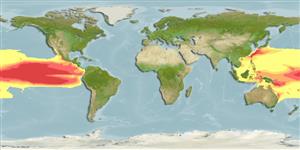>
Myctophiformes (Lanternfishes) >
Myctophidae (Lanternfishes) > Lampanyctinae
Etymology: Lampanyctus: Greek, lampas, -ados = torch + Greek, nykte = night (Ref. 45335).
Eponymy: Professor Carl Levitt (Leavitt) Hubbs (1894–1979) was a giant of American ichthyology. [...] (Ref. 128868), visit book page.
Environment: milieu / climate zone / depth range / distribution range
นิเวศวิทยา
เกี่ยวกับทะเล,น้ำเค็ม สัตว์ผิวน้ำในเขตน้ำลึก; ระดับความลึก 0 - 2500 m (Ref. 40966). Deep-water
Pacific Ocean. South China Sea (Ref.74511).
ขนาด / น้ำหนัก / Age
Maturity: Lm ? range ? - ? cm
Max length : 3.0 cm SL เพศผู้/กระเทย; (Ref. 44036)
Life cycle and mating behavior
วัยเจริญพันธุ์ | การสืบพันธุ์ | การวางไข่ | เซลสืบพันธ์ของเพศเมีย(ไข่) | ความดกของไข่ | ตัวอ่อน
Paxton, J.R., 1979. Nominal genera and species of lanternfishes (Family Myctophidae). Contrib. Sci. Natur. Hist. Mus. Los Angeles County, 322:1-28. (Ref. 5572)
IUCN Red List Status (Ref. 130435: Version 2024-1)
Threat to humans
Harmless
Human uses
เครื่องมือ
Special reports
Download XML
แหล่งที่มาจากอินเตอร์เน็ต
Estimates based on models
Preferred temperature (Ref.
123201): 4.4 - 13.7, mean 6.4 °C (based on 167 cells).
Phylogenetic diversity index (Ref.
82804): PD
50 = 0.5000 [Uniqueness, from 0.5 = low to 2.0 = high].
Bayesian length-weight: a=0.00871 (0.00318 - 0.02383), b=3.00 (2.76 - 3.24), in cm total length, based on LWR estimates for this (Sub)family-body shape (Ref.
93245).
ระดับชั้นอาหาร (Ref.
69278): 3.1 ±0.3 se; based on size and trophs of closest relatives
ความสามารถในการกลับคืนสู่ปกติ (Ref.
120179): ความสูง, เวลาต่ำสุดที่จะทำให้ประชากรเพิ่มขึ้นเป็น 2 เท่าใช้เวลาน้อยกว่า 15 เดือน (Preliminary K or Fecundity.).
Fishing Vulnerability (Ref.
59153): Low vulnerability (10 of 100).
